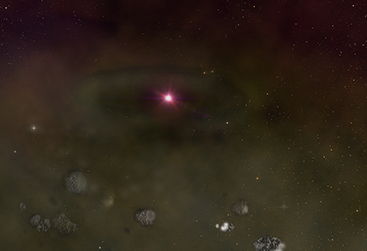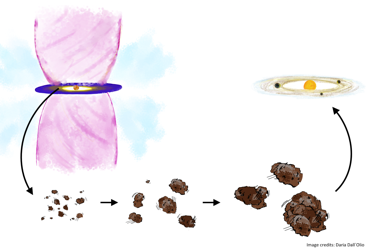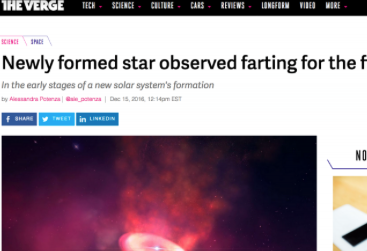Resolving star formation with ALMA
The Resolving star and planet formation with ALMA (REALM) project was initiated in 2015. Initially, we observed carbon monoxide (CO) in the young TMC1A protostellar system at the highest possible spatial resolution with ALMA. The obtained images showed CO and dust on spatial scales of only 6 au and revealed the presence of a disk wind. The REALM project is now being continued with the support from the Swedish research council and in 2017, we continued the long baseline observations with ALMA.
Team members: Per Bjerkeli, Jon Ramsey, Hannah Calcutt, Matthijs H. D. van der Wiel, Daniel Harsono, Lars Kristensen and Jes Jørgensen.

Press clippings
 Planet formation starts before star reaches maturity
Planet formation starts before star reaches maturity
A European team of astronomers has discovered that dust particles around a star already coagulate before the star is fully grown. Dust particle growth is the first step in the formation of planets. The researchers from the Netherlands, Sweden and Denmark publish their findings in Nature Astronomy.
 Newly formed star shoots out powerful whirlwind
Newly formed star shoots out powerful whirlwind
Researchers from the Niels Bohr Institute have used the ALMA telescopes to observe the early stages in the formation of a new solar system. For the first time they have seen how a powerful whirlwind shoot out from the rotating disc of gas and dust surrounding the young star. The results have been published in the prestigious scientific journal, Nature.
 Newly formed star observed farting for the first time
Newly formed star observed farting for the first time
For the first time, scientists have observed the powerful whirlwinds shooting out of a newly formed star located 450 light years away. The space outbursts occured in the early stages of a new solar system's formation, when young stars are known to emanate jets of gas.
Selected publications
- Resolved molecular line observations reveal an inherited molecular layer in the young disk around TMC1A
- Kinematics around the B335 protostar down to au scales
- Evidence for the start of planet formation in a young circumstellar disk
- Resolved images of a protostellar outflow launched by an extended disk wind
